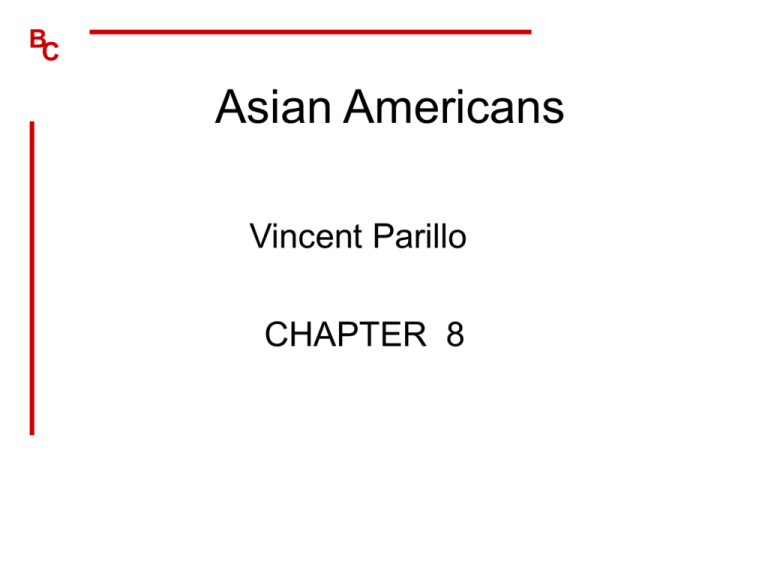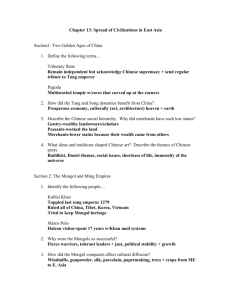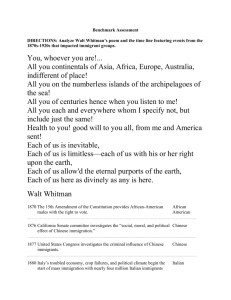Chapter Eight - Bakersfield College
advertisement

BC Asian Americans Vincent Parillo CHAPTER 8 BC Sociohistorical Perspective • Chinese first immigrated in 1850 – Japanese, Koreans, and Filipinos followed • Sojourners • Chinese encountered racial hostility almost as soon as they arrived • Not allowed to compete with Whites economically, .. forbidden education, … to testify in court, … bared from citizenship • Chinese Exclusion Act of 1882 BC Asian Cultural Attributes • Great Social Distance, … set pattern of interaction • Not a homogeneous group, varied cultures – Language, … religion, … • Suffered from miscegenation laws BC Chinese Structural Conditions • 1842 Stereotype, .. (before immigration) – Cold, … cunning, … distrustful, … covetous, … deceitful, … quarrelsome, … vindictivce • Ethnophaulisms, … dirty, … disease ridden, … (also those above) • Societal reaction, … “Cries of restrictions” • Legislative Actions, due to economic woes, and [White] labor agitation BC Legislative Action Cont. • Chinese Exclusion Act of 1882 – Action to limit Chinese from competing economically – First time the government restricted a whole race if individuals from immigrating • In 1884, restrictions tightened further • Violence against Chinese – Mob action, … murder, … driven from homes • Rock Springs Wyoming BC Legislative Action Cont. • Exclusion extended in 1892 • Extended indefinitely in 1902 • Organized labor created and instigated anti-Chinese legislation BC Avoidance and Separation • Some returned to China • Others sought redress in courts • Were expelled from various trades and occupations • Had to congregate in Chinatowns – Los Angeles, … [Bakersfield], … • Intermarriage, … miscegenation laws – 14 States had antimiscegenation laws BC Current Patterns • Since 1965 population has increased, Table 8.1 • Have expanded China towns or moved out – Los Angeles, … Monterey Park, CA • China Towns, both tourist attractions and slum communities • Increasing youth rebelliousness, crime and gang activity BC The Japanese • Economic Competition, … conflict – Organized Labor, … vegetable growers, … farmers, … unions • 1913, California legislature passed the first alien landholding law – Can’t own land if ineligible for citizenship – U.S. Naturalization Act of 1790 • U.S. born children could own land – CA in 1920, prohibited aliens from being guardians of a minor’s porperty BC National Policy • 1906 San Francisco school board – Japanese children to Chinese schools – Japanese Government Pressure • A compromise was reached, called the “Gentleman’s Agreement” – Japanese would restrict immigration – (Loophole) Permission for wives to enter U.S. • Park’s statement, … p. 307 • Immigration Law of 1924, bared Japanese BC Expulsion and Imprisonment • After Pearl Harbor, Dec. 7, 1941 • “Our worst wartime mistake” • Many 2nd and 3rd generation Japanese Americans were placed in “relocation centers” – Had to sell all their property, … [example] • Mass expulsion proved unnecessary for national security • No mass evacuation in Hawaii BC Relocation Cont. • Relocation Centers – More than 110,000 relocated – Manzanar, CA … Poston, AZ • Forced to sell almost all of their possessions, … forty lbs. per person – Santa Anita • Largely limited to the West Coast • No mass evacuation in Hawaii BC Relocation Cont. • • • • • Housing conditions, … Ted Nakashima’s description, … (p. 310) Some left to go East, … jobs, … school Some left to go into the Army, … Endo v. United States, … ended relocation • 1988, … apology and reparation • Education, … and Intermarriage BC Relocation Cont. • • • • • [Other examples], not in Parrillo, 2003 Bakersfield: The Ono family Yakima Washington Non- Japanese internees The fisherman, Monterey California BC Recent Patterns • U.S. occupation (WW II) and Japanese reconstruction • Japanese War brides (WW II) • Parents encouraged education – Above national norms, .. professional positions • Cultural emphasis: … conformity, .. Aspiration, …competitiveness, … discipline • Intermarriage: Yonsei exceeds 50% • Population decline as an Asian proportion BC The Filipinos • • • • 1898, Philippines a U.S. possession U.S. nationals but not U.S. citizens Could not attain citizenship, ..not White Replaced Japanese labor after the “Gentlemen's Agreement” • Due to Immigration Act of 1924, replaced Mexican labor, … farm and service labor • Scarcity of women BC Koreans • 1903, recruited to replace Chinese labor in Hawaii • Numbers increased after the Korean War • 2000 population, … 1.1 million • 40% of males operate their own business • Dominate certain businesses in different cities, (p. 319) • Koreans use of the “kye” • Middleman minority, … see fig. 8.3 BC Sociological Analysis • The Functionalist View • Conflict view






